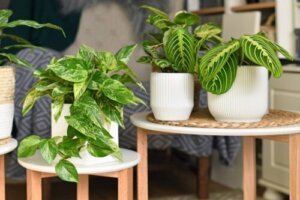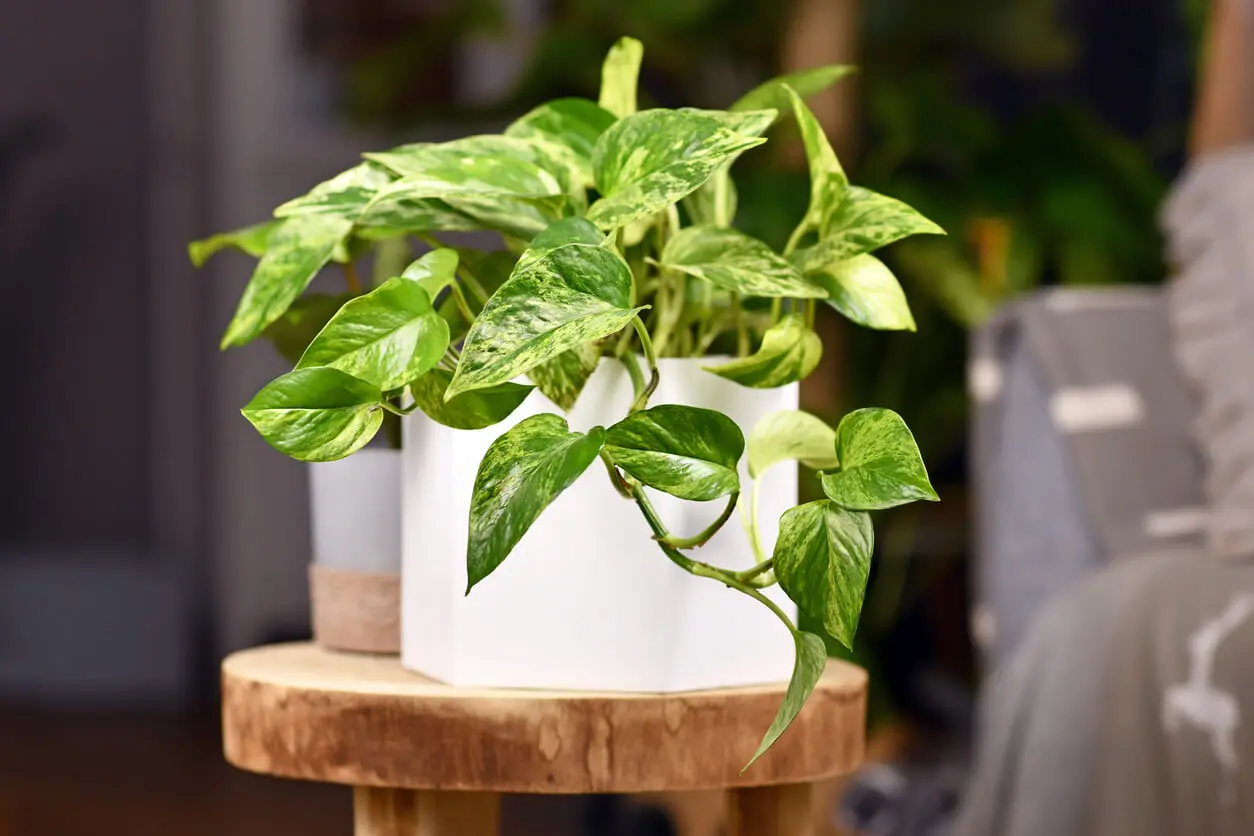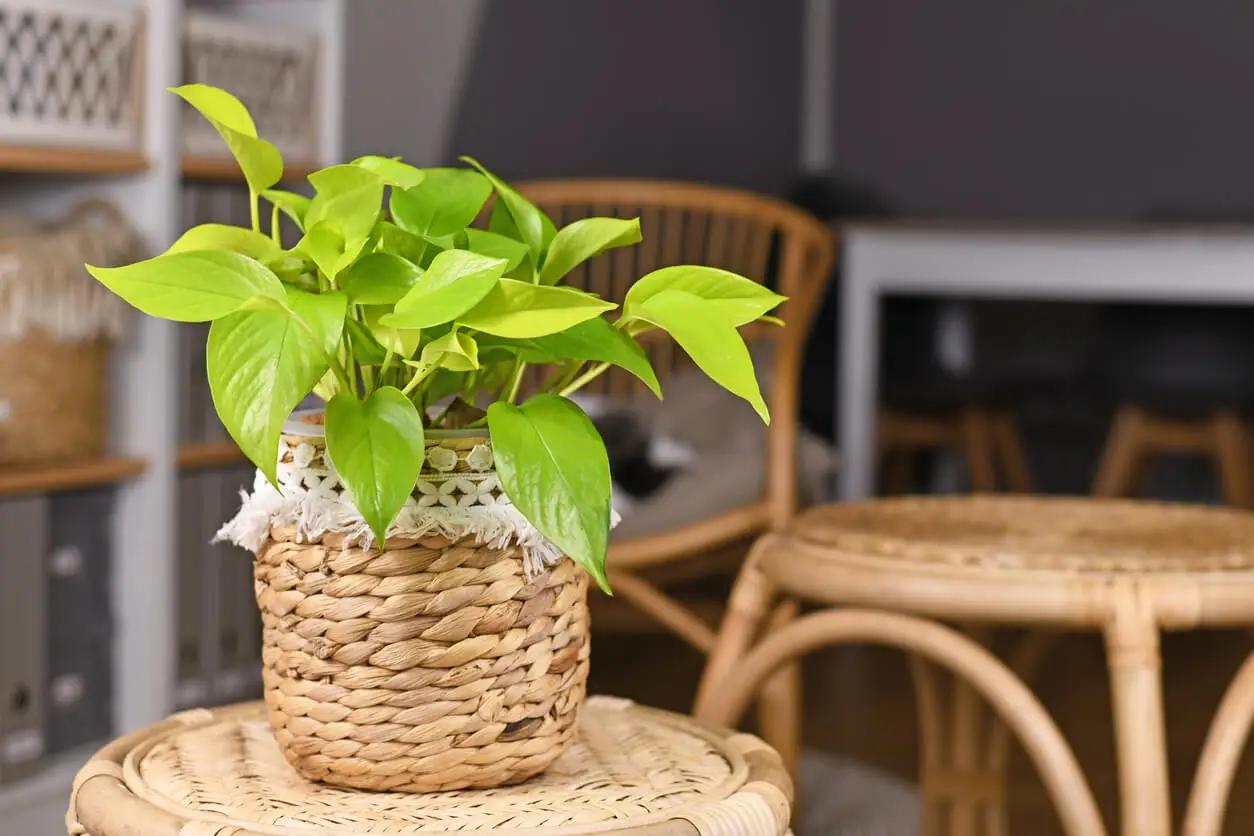An Easy Guide to Pothos, a Quintessential Houseplant

The pothos plant has enough qualities to be one of the favorites inside the home. The beauty of the large leaves and the greenery that adorns it are attributes that add to the simple care that it demands, since they do not go beyond the elementary for any plant species.
As if that were not enough, having a specimen in any room of the house is to have the purifying benefits it offers to the environment.
The pothos is an excellent option for those who begin in the world of gardening, because it allows learning about the basic care of a shrub. And for those who have already mastered the art of gardening, this species belonging to the Araceae family becomes a “walk in the park”, compared to the meticulousness and demand that its peers imply. We show you how to take care of them.
The pothos plant and its characteristics
A publication published by the Rasayan Journal of Chemistry exposes the pothos (Epipremnum aureum) as a genus of flowering plants useful in folk medicine and from which numerous compounds are released. The same, in scientific papers, reports prominent bioactivities.
Born in Southeast Asia, it is also known as photos and is characterized by climbing behavior in tropical forests. Smaller shrubs are adapted for cultivation in gardening and incorporation into interiors because they thrive in pots and have the ability to grow drooping, i.e., they look pendulous.
The pothos has an imposing appearance, evidenced by its broad, green, evergreen leaves, pigmented with creamy highlights and resembling a heart. At birth, these leaves grow entire, but once the species matures they become pinnate.
The common pothos is called potus dorado. A variety identified as poto marble queen is distinguished by white leaves and intense spots; while another type, called potus neon/lemon has leaves without spots and yellow color.
The benefits of having a pothos plant inside the house
Pothos is a plant that survives without major inconveniences inside and outside the house. However, when the climate is excessively cold, there is a risk of disease for the specimen.
You place it on furniture, hang it or have a tutor for it to entangle itself. With its heart-shaped leaves, it makes an eye-catching Valentine’s Day gift. But its most prominent benefit is air cleaning.
These purifying properties are associated with the absorption and elimination of toxins such as formaldehyde, released from cosmetics, detergents, paints and other materials used at home. In fact, a NASA study refers to the possible impact of golden pothos plant on indoor air quality, after testing a model of pollutant traces in a spacecraft simulator.

Pothos plant care needs
Monaco Nature Encyclopedia notes that Epipremnum aureum is one of the most widely grown potted plants because of its adaptability, easy maintenance and speed of growth. They add that fundamental attentions contribute to the lush vegetation and the potency of its colors.
What are these cares? We will see them in a moment.
Fertilizer
The growing medium for the Araceae species must provide it with sufficient nutrients; ask for special fertilizers for this kind of plant. Supply fertilizer every month while the plant is still growing; once it is dormant, fertilize once every quarter.
Watering
The tropical origin of the pothos is not an argument for saturating it with water. On the contrary, they require little hydration and defend themselves in scarce conditions. It is necessary to water the photos when you notice the dry substrate; generally, every 2 or 3 days.
If you go too much wetting the plant, its green leaves turn yellowish. Or, as a defense mechanism, it detaches the damaged ones.
Lighting
Place the specimen in a luminous area, even if it is next to a window with curtains. Direct light is not convenient for this plant, but in case it lacks illumination, it could lose its lower leaves, which serves as an alert to move it from its place.
Pruning
When the plant experiences a pause in its growth, take advantage of it and prune it. There is no specific time of year to do this; you can execute the cut at any time.
Reproduction and transplanting
Reproduction of pothos is by cuttings. Cut off the tip of a branch, dip it in water and wait for it to root. Next, plant it at the base of another plant to make it look bushy.
On the other hand, it is possible to plant it directly in the ground, but it would be more difficult to thrive if you then transplant a cutting into water. Transplanting is recommended in spring, when the pot is dry or if it shows abundant moisture. In the last 2 cases, the idea is to move the plant to a pot with new substrate to try to revive it.
Disinfection
Like any other vegetable, pothos is susceptible to pests. Frequent diagnoses reflect mealybug damage; they can also suffer from scales or dark bumps that extend down to the stem.
To combat these infections, it’s best to get rid of wilted leaves, move the plant to an insect-free pot and sterilize pruning tools. If the mealybug infestation is severe, remove the shrub to fresh air and rinse it carefully. Then move it to a lighted spot with a minimum amount of water.

Caution! Take certain precautions to avoid poisoning caused by the pothos plant
Among the many advantages of having pothos as a houseplant, there is an important warning: the species is toxic. People with high skin sensitivity may develop a rash.
Particularly in the case of pets, the American Society for the Prevention of Cruelty to Animals notes that chewing or eating the leaves affects the oral tissues, and causes pain and swelling, vomiting, and excessive drooling. Consumption of pothos also results in mechanical irritation of the gastrointestinal tract.
According to Bonplandia magazine, these reactions are due to a toxic syndrome caused by oxalates contained in houseplants. In conclusion, the advice is to keep your pothos out of reach of animals and children to enjoy the beauty of this ornamental vegetable.
All cited sources were thoroughly reviewed by our team to ensure their quality, reliability, currency, and validity. The bibliography of this article was considered reliable and of academic or scientific accuracy.
- Bhattacharyya, NK., Bordoloi, MJ y Dutta, D. (2021). Género pothos: una revisión de los constituyentes químicos y las actividades biológicas. Revista Rasayan de Química, 14(3). Revista Rasayan de Química, c/o Dr. Pratima Sharma. http://rasayanjournal.co.in/admin/php/upload/3313_pdf.pdf
- Martínez, M., Varela Romero, C., Vizcarrondo, G. (2017). Plantas ornamentales tóxicas en Venezuela. Bonplandia, 26(1). Venezuuela. https://revistas.unne.edu.ar/index.php/bon/article/view/2073?locale=es_ES
- Puccio, P. Epipremnum aureum. Monaco Nature Encyclopedia. https://www.monaconatureencyclopedia.com/epipremnum-aureum/?lang=es
- Redacción ASPCA. 17 plantas venenosas comunes. Sociedad Americana para la Prevención de la Crueldad hacia los Animales. Estados Unidos. https://www.aspca.org/nyc/recursos-para-personas-que-hablan-espanol/17-plantas-venenosas-comunes
- Redacción ASPCA. Hiedra del diablo. Sociedad Americana para la Prevención de la Crueldad hacia los Animales. Estados Unidos. https://www.aspca.org/pet-care/animal-poison-control/toxic-and-non-toxic-plants/devils-ivy
- Ursprung, M., Amiri, A., Kayatin, M., Perry J. (2016). El efecto de los potos dorados en la reducción del nivel de compuestos orgpanicos volátiles en una cabina de nave espacial simulada. Servidor de informes técnicos de la NASA. Estados Unidos. https://ntrs.nasa.gov/citations/20160005687
This text is provided for informational purposes only and does not replace consultation with a professional. If in doubt, consult your specialist.








